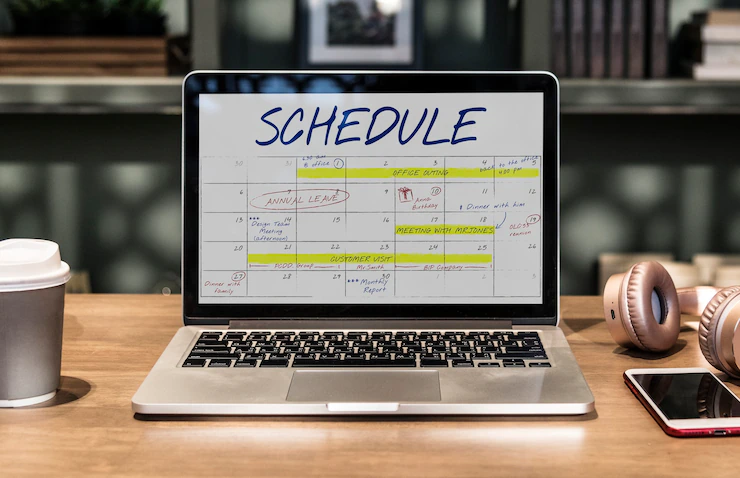9 Best Practices Of Time And Attendance Management
8 Mins Read
Published on: 07 February 2023
Last Updated on: 14 November 2024

toc impalement
Time management and work attendance are integral to a company’s overall productivity, which yields more revenue. However, when absences are increasing and employees’ attendance is not keenly checked, work performance will drop and affect the company’s position in the market.
Whether your employees work in the office or remotely, the good news is that there are effective ways to track their attendance and ensure that they perform according to company standards.
Having organized attendance management in place will keep everyone working together like a well-oiled machine, resulting in business success. This case study will show you how tracking attendance can drive business growth.
Let’s Checkout Nine Prime Practices Of Time And Attendance Management:
Apply the following practices of time and attendance management to ensure productivity and efficiency in your workplace:
Let’s Checkout Nine Prime Practices Of Time And Attendance Management:
Apply the following practices of time and attendance management to ensure productivity and efficiency in your workplace:
1. Utilize An Effective Attendance Monitoring System

People are the most critical assets for any organization, entity, business, or institution. And it makes sense to establish a good foundation among your employees.
Trust is earned when they work hard and contribute to your company’s growth. However, it’s helpful to implement the best attendance monitoring system to ensure that your staff delivers the tasks ethically.
After all, using an attendance management system is the first step to maximizing employee productivity.
Gone are the days when you had to depend on old-school attendance trackers such as the punch-in-punch-out systems.
Thanks to the advent of technology, companies can now invest in convenient attendance management software, allowing the person in charge to monitor and track employees’ time and attendance.
This time-saving app generates accurate results and leaves no room for errors, unlike conventional time-tracking methods. Also, the system is encrypted with passwords and IDs, so only authorized personnel can gain access.
Your attendance system should be centralized and tracked using modern-day technology. If you haven’t yet, this is one effective tech tool you should invest in as soon as possible. Time and attendance management systems have never been more critical. Especially if your entity is growing and manual trackers are no longer cutting it, it’s paramount to expedite attendance checks through a sturdy monitoring system.
2. Allow Flexibility For Schedule Requests
Many companies have raised the bar high when introducing work-life balance and giving employees more freedom to program their work schedules. Join the bandwagon and allow your employees to choose their day off.
They should be living a life outside of work, and enabling them to have flexible schedule requests can boost employee morale. Finally, when they have high work enthusiasm, productivity also follows.
Give your employees enough time to spend with their families and loved ones. Their mental health will benefit from this semblance of work-life balance. Therefore, consider reviewing requests submitted by team members.
As long as you can arrange your employees’ schedules in both parties’ favor, everything will turn out well. Tools like Kronos can assist employee training for scheduling. The key here is to make everyone review their schedules ahead of time so you can organize them well.
However, you must also make room for flexible changes in case necessary adjustments arise without much time.
Value your employee’s overall well-being. After all, it will also benefit the company when employees don’t have to lie and make excuses only to get a day off. Work conflicts and work delays can be avoided in this manner.
3. Limit The Amount Of Overtime
Unfortunately, one of the stressors for workers is the amount of overtime. Limiting employee working hours after office hours is an excellent way to manage time and attendance and ensure they don’t burn out at work soon.
Putting such a restriction in place will allow employees to manage their time better by finishing their work on time. It also saves more costs for the company, considering that you won’t have to shell out money for overtime pay or suffer from mentally or physically sick employees.
Overtime work usually exhausts employees, resulting in poor performance. Consequently, tasks will take longer to complete because they’re already overworked. It can take a toll on both their physical and mental state.
Over time, they might need to consume more medical expenses and insurance coverage shouldered by your company. Hence, it’s crucial to limit overtime work.
4. Allow Employees To Monitor Their Progress With Attendance
Allow your employees to assess how they can improve their timekeeping and attendance. You can do this by giving them access to the monitoring system.
Of course, they shouldn’t be able to perform any unethical edits. However, give them enough access to check and evaluate how they can improve their attendance.
When they have access to information about their working hours and attendance, they’ll be able to spot the things they need to change and realize bad habits that need to stop. They’ll also appreciate the company for allowing them to do this so they can work harder and improve their skills.
Another tip is to delegate managers and team leaders to give attention to staff who need reminders for poor attendance. One-on-one coaching can be done so these employees can understand how or why their attendance is below what’s expected.
Managers can then evaluate employees’ progress and provide possible solutions when necessary. Managers and employees can also communicate effectively in this way.
5. Give Room For Flexible Scheduling

Too rigid working schedules can lead to unproductivity and demotivation among workers. Employees’ physical and mental health can be adversely affected, especially if they’re stuck on an unsuitable schedule that they’re not pleased with. As a result, allowing them to work at their preferred time is essential.
Nowadays, work styles are getting more flexible, as many offices transition to working from home. If your staff is already working freely anywhere, include flexible scheduling too.
Give them the freedom to start and end work whenever it’s best for them, as long as they meet the number of hours needed for the day’s work.
Remember to prioritize employees’ health and wellness; by applying flexible work styles, employees will remain happy and satisfied with their jobs. Team members can maximize their performance and minimize absences due to illness by rotating shifts.
Also, your employees’ attachment to the organization will increase when you offer flexible working hours. They will appreciate your concern for their welfare and health.
However, even flexible scheduling can still be tracked and monitored effectively through software. It lets the management know whether the employees have met the required working hours to ensure their performance and productivity.
6. Establish A Clear Attendance Policy
As far as attendance is concerned, your workers should be aware of what is expected of them. It is where a clear attendance policy should come in handy.
It entails all the rules and regulations about managing time and attendance for work. The policy should include all details such as reporting absences, penalties for excessive absenteeism, incentives for perfect attendance, and so on.
Establishing this attendance policy as early as possible is essential. Also, draft email reminders about your attendance policy at least once or twice a year.
The policy should include all the things employees need to do when they take a leave, experience an emergency, or request to switch schedules with others. Include the authorized people whom they should contact in these situations.
You should always have a clearly defined HR policy. The key here is to ensure that absences are minimal and that their excuses are valid.
7. Integrate Attendance With Payroll
Another good practice for time and attendance management is integrating them with salary. Payroll is dependent on accurate employee attendance management.
However, this could mean you may overpay or underpay your employees if there are errors in your attendance data. Hence, it’s crucial to keep attendance records as accurate as possible.
In the case of a large and dispersed workforce, manually analyzing attendance data for payroll can be time-consuming and lead to more significant errors. It is when an attendance tracker is best to work with.
Businesses can use clock-in clock-out apps or time-tracking software to eliminate inefficient payroll processes. HR departments don’t have to run payroll using pen and paper or spreadsheets, which can waste time and money. Furthermore, time tracking software eliminates manually checking employee timesheets and managing paid time offs (PTOs).
Choose a time-tracking app with the best features to offer that suit your attendance management and HR needs. Increase accountability with GPS tracking, geofencing, facial recognition, and IP address locking. Moreover, you can streamline payroll using a time-tracking software app with project tracking, time off tracking, accruals, payroll reporting, and payroll provider integrations.
Integrate it into the payroll system, so it can automatically show deductions for absences incurred. Such a tool will make HR and accounting work easier during payroll.
8. Review Holidays And Leaves
If possible, try to reassess the number of holidays and leaves allocated to your employees. And if your company can afford to award more, so be it.
As mentioned, your work culture should establish the importance of work-life balance, and having more leaves and holidays granted to employees will achieve this.
You’ll realize that this is more productive than employees having to lie about absences, and the good thing is that the days are pre-planned, so they won’t disrupt any tasks and cause project delays.
Create an employee engagement program or incentive scheme. For instance, you can give extra paid vacation leaves for your top-performing employees or once your team meets your sales quota.
Integrate your team-building activities, awards, and other engagement activities into your extra paid leaves. These strategies can promote good employer-employee relationships and loyalty.
9. Assess The Reasons Behind Absenteeism In The Workplace

Finally, another valuable tip to improve your attendance management is to discover the reasons behind absenteeism in the workplace.
If you notice an increase in the number of absences among employees, it’s best to find the root cause. Let managers talk to these staff and help them to avoid more absences in the future.
Your attendance policy should dictate how you deal with absenteeism, and the consequences should be consistent. Sanctions alone aren’t enough to address unscheduled absences.
Providing your employees with support and understanding is also essential. Being sensitive about their conditions and concerns is vital in helping them defeat absenteeism.
You can be more flexible with coaching sessions and meetings, including small or heart-to-heart talks with employees. Once you master employee coaching, you can create a more productive and happier team, reducing absenteeism.
In addition, hiring a counselor can also help assess employees’ psychological status and give them a professional avenue or help to express their emotions and thoughts.
Conclusion
With the tips mentioned in this article and effective attendance management software, your business can better manage work productivity and employee attendance.
A system such as this can provide results regarding each employee’s performance, give time management training if required and attendance can looked over.. In turn, you can boost your business as you monitor and review what things and policies need to be changed and done to improve work performance.
Read Also:


















Comments Are Closed For This Article